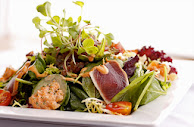Panna cotta ("cooked cream") is a silken, eggless, Italian custard, made by simmering cream, milk and sugar, mixing with gelatin, and then allowing the custard to chill until set. It is an easy-to-make dessert, often complemented by perfectly ripe berries. Some versions incorporate yogurt, creme fraiche, mascarpone cheese, spices, or other infused flavors into the custard. You can make the panna cotta in individual ramekins and unmold them just before serving, in individual decorative dishes and serve in those, or in a large gratin dish and spoon it out at the table family-style.
 |
| Meyer Lemon and Basil Crème Fraiche Panna Cotta with Blackberry Puree |
As I typically do with the Daring Bakers' and Daring Cooks' challenges, I reviewed the challenge recipe provided, and then spent far too much time reading every other similar recipe I could find, from my cookbook collection and online, before proceeding with the challenge. However, it's very educational and I enjoy reading about the history of the dish and variations that have developed. I often reach for The Flavor Bible: The Essential Guide to Culinary Creativity, Based on the Wisdom of America's Most Imaginative Chefs when I want to be a little more daring and experimental with flavor combinations.
when I want to be a little more daring and experimental with flavor combinations.
I've made a few different versions of panna cotta in the past. The recipe I chose to adapt for this Daring Bakers' challenge is very similar to the recommended recipe by Giada De Laurentiis, but it also incorporates crème fraiche to balance the sweetness of the fresh fruit with some tang. I also wanted to use a few of the beautiful Meyer lemons sitting on my counter, so I added lemon zest to the custard. I went a bit further by infusing fresh basil into the custard. Finally, I prepared a fresh blackberry puree, with a squeeze of lemon juice, to spoon over the top of the chilled dessert. The flavors meld beautifully together, especially the hint of basil, and this was a refreshing dessert after my French Fridays with Dorie Red Wine and Port Braised Short Ribs.
Meyer Lemon and Basil Crème Fraiche Panna Cotta with Blackberry Puree
Adapted from Crème Fraiche Panna Cotta with Strawberries, Susan Goin's
Ingredients
1/2 cup cold whole milk
Two 1/4-ounce packages unflavored powdered gelatin
3 cups heavy whipping cream
5 tablespoons granulated sugar
1 cup loosely packed basil leaves, coarsely chopped, plus a few whole basil leaves for garnish
Zest of one Meyer lemon, plus additional zest for garnish if desired
1/2 cup plus 2 tablespoons crème fraiche
Vegetable oil, if using molds
For blackberry puree
2 pints fresh blackberries, with 1/2 pint whole berries reserved for garnish
1/4 cup granulated sugar, plus 1 tablespoon to toss with reserved fresh berries
1/4 cup water
1 tablespoon Meyer lemon juice
Preparation
Place the milk in a large bowl. Sprinkle the gelatin over it and stir to combine. Let stand while you prepare the remaining ingredients.
If you plan on pouring the panna cotta into molds and inverting onto a plate once chilled, lightly oil your ramekins or molds with vegetable oil.
Pour whipping cream, sugar, and chopped basil into a heavy medium saucepan and stir over medium heat just until the cream starts to boil. Turn off the heat and allow to cool for about 5 minutes. Pour mixture into blender and carefully blend to help infuse the basil. You can also use a hand-held immersion blender and blend right in the saucepan.
Slowly whisk the infused cream into the gelatin, and then whisk in the crème fraiche.
Strain the mixture, stir the lemon zest, and pour it into prepared ramekins, molds, or glasses.
Chill in the refrigerator for at least 3 hours, and up to two days if well-covered and chilled.
To prepare the blackberry puree: Put the 1-1/2 pints blackberries in a small saucepan with the sugar, water, and lemon juice. Bring to a simmer over low heat and continue simmering, stirring occasionally, for about 5-10 minutes. Puree blackberries in the blender and strain through a fine mesh sieve.
Cover and set aside if using within a few hours, or refrigerate. Use at room temperature.
Serving Panna Cotta:
About 10 minutes before serving, toss the whole berries in a little sugar, to taste.
If using molds, smear or puddle some of the blackberry puree on the plate, invert the panna cotta onto the puree, and garnish with fresh berries, lemon zest, and a few fresh basil leaves. If serving in a ramekin or glass, spoon some puree over the top of the panna cotta and garnish with fresh berries, basil and zest.
****
After reviewing and comparing several Florentine Cookie recipes to the Nestle recipe, I preferred those that used ground almonds instead of quick-cooking oats.
 |
| Italian Florentine Lace Cookies |
Italian Florentine Lace Cookies
Adapted from Food Network Kitchens and One Perfect Bite
1/2 cup ground almonds (about 2 ounces)
5 tablespoons unsalted butter
1/4 cup firmly-packed light Muscovado sugar (India Tree Light Muscovado Sugar, 1 Pound (Pack of 4) ), or substitute light brown sugar
), or substitute light brown sugar
2 tablespoons granulated sugar
2 tablespoons light corn syrup
1/3 cup all-purpose flour
Pinch salt
1 teaspoon pure vanilla extract
3-4 ounces dark chocolate, chopped
Preheat oven to 350 degrees F. Position two oven racks in the middle and upper third of oven. Line three baking sheets with silpats or parchment paper.
Using a teaspoon, drop batter by rounded teaspoons onto prepared baking sheets, spacing cookies 3 inches apart (6 cookies per sheet). It's important to drop the batter onto the baking sheets while it is still warm, so it doesn't harden too much. It will be sticky. The cookies do spread quite a bit (about 4 inches in diameter), so it's important to leave enough space between the cookies. I only used two baking sheets and some of my cookies baked into each other.
Bake cookies 8 to 10 minutes (rotating sheets half way through) until cookies have spread, and are thin and golden brown.
While cookies are baking, prepare wire cooling racks by covering with a sheet of plastic wrap. When cookies are done baking, remove baking sheets from oven and allow cookies to remain on baking sheets for a few minutes until they are firm enough to transfer. Gently transfer cookies with a rubber or offset spatula to plastic wrap covered cooling racks and allow to cool completely.
Put the chocolate in a medium heatproof bowl. Bring a saucepan filled with about an inch of water to a very low simmer; set the bowl over, but not touching, the water. Stir the chocolate occasionally until melted and smooth. Drizzle over cooled cookies and set aside at room temperature until chocolate is set.
Immediately store cookies, carefully, separated by squares of parchment paper or waxed paper, in an air-tight container for up to 3 days.
Thank you, Mallory, for your Creamy, Dreamy, Crunchy, Sweet February Challenge! The Panna Cotta was a classic challenge, allowing the Daring Bakers to showcase their creativity with amazing flavor variations and plating. Although I was vaguely familiar with Florentine cookies, I welcomed the opportunity to make them for the first time, and absolutely adored the elegant and lacy look, light and crispy texture, and lovely taste.
For the complete challenge recipes, please visit The Daring Kitchen Recipe Archive, and take a browse-through the Daring Bakers' Blogroll to see what some of the other members created this month.




















































